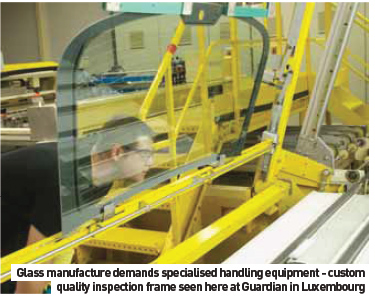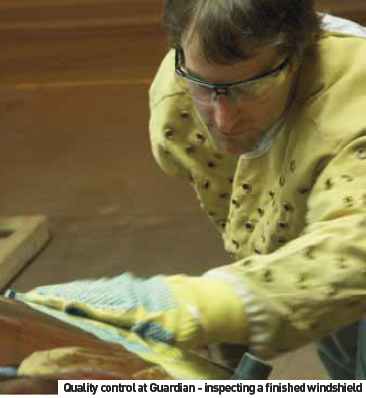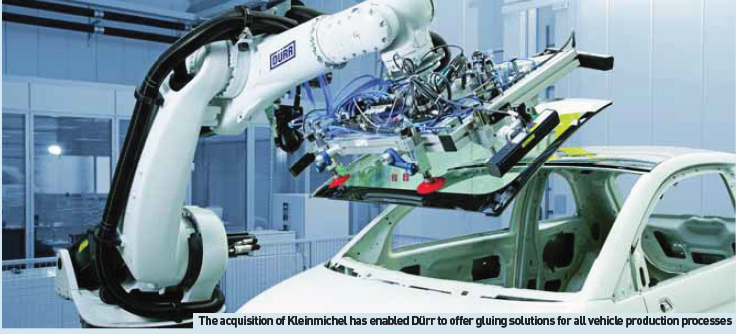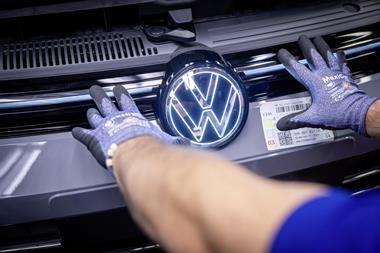
Designers and engineers in automotive production view glass as a rather tiresome necessity; fragile and brittle, it is not an ideal material to install in a machine subject to torsional stresses, severe jolts and almost constant vibration. In the early days of motoring, glass windscreens replaced goggles as a method for simply keeping wind and rain out of the driver’s eyes. Celluloid (an early form of plastic), remained popular for side and rear windows until the 1940s.
As production of glass steadily increased, so it increasingly became viewed as a commodity. Yet advances in its manufacture have seen the development of various types and processes. Toughened glass, where the final shaped and sized pieces are heat treated to provide added strength is still widely used in side and rear windows. Windscreens in most markets are required to be made from laminated glass, where a thin sheet of a plastic is sandwiched between two glass layers to add strength and prevent shattering in the event of a collision.
Where there were once hundreds of independent automotive glass manufacturers, production has been narrowed down to a few major companies, including Guardian Automotive, part of Guardian Industries, one of the world's largest manufacturers of float glass and fabricated glass products. The company manufactures and supplies the automotive industry with a variety of exterior products.
 AMS spoke to Albert Franck, Managing Director of Guardian Automotive’s Grevenmacher, Luxembourg, plant about the challenges of manufacturing specialized glazing for the European automotive market.
AMS spoke to Albert Franck, Managing Director of Guardian Automotive’s Grevenmacher, Luxembourg, plant about the challenges of manufacturing specialized glazing for the European automotive market.
AMS: Can you talk about the range of automotive glass products in your portfolio?
Albert Franck:We focus on windshields and backlights here in our Luxembourgish auto glass facility in Grevenmacher – side glass is produced by our sister companies. For the backlights, we supply heat-strengthened, tempered and annealed laminated glass. In the laminated product range, we supply tinted and coated glasses. For the windshields, we use green body-tinted and silver-coated glass. We also embed tungsten wires into the laminate; these are used as heating elements or as antennas.
AMS: What is the balance between the high-volume glass you produce and custom or short-run pieces?
AF: Since the start of production at Grevenmacher, we have moved away from high-volume production towards the special product business. Typically we are supplying to higher-segment vehicles, with very limited volumes. The maximum volume we produce per model would be around 200,000 pieces per year, for example, in the Audi A3. The average is around 100,00 per year for models like the Volkswagen Passat CC coupé or the Mercedes GLK.
Examples for a short run or special car application would be the Porsche Panamera or Audi A8. These high-end vehicles demand a lot of different versions of the same glass component. The OEM may specify up to 12 different versions of windshields or backlights for this type of vehicle. AMS: Raw materials - where are do you usually procure the glass sheet and ancillary pieces?
demand a lot of different versions of the same glass component. The OEM may specify up to 12 different versions of windshields or backlights for this type of vehicle. AMS: Raw materials - where are do you usually procure the glass sheet and ancillary pieces?
AF: We buy our raw glass internally from our Guardian sister float glass companies, that are located all around the world: in the US, Thailand and here in Luxembourg. We also source glass for different specialities, from the US, Thailand, and from here in Luxembourg. Guardian buys the sand to produce flat float glass. We manufacture bent auto glass components, add plastic framing, mirror buttons etc. These components are delivered in the required sequence to the OEM assembly line.
AMS: Which machines do you use most, including furnaces, etc?
AF: To produce auto glass we use cutting and grinding equipment, silk screening printers, electric bending furnaces, washing machines for flat and bent glass, autoclaves, laminating devices, soldering and other assembly machinery. AMS: Frames, moulds and other tooling. Do you buy all of these in or manufacture in-house? AF: We design and maintain 100% of our tools in-house. We produce 50% of these internally and buy the remainder from our specialised partners.
AMS :Which machine makers do you use?
AF: We buy our equipment from a group of machine builders that are specifically focused on supplying the glass industry.
AMS: How do you attempt to control energy costs in heating and other production areas?
 AF: Cooling down and re-heating furnaces is very expensive, so we optimise by running them 24 hours, 7 days a week. We use a lot of energy in our washing machines, but unlike the furnaces, where it is difficult to recover heat energy, we are recuperating as much heat as possible from our waste water. Our plant is certified under ISO 14001 for our environmental protection policies.
AF: Cooling down and re-heating furnaces is very expensive, so we optimise by running them 24 hours, 7 days a week. We use a lot of energy in our washing machines, but unlike the furnaces, where it is difficult to recover heat energy, we are recuperating as much heat as possible from our waste water. Our plant is certified under ISO 14001 for our environmental protection policies.
AMS: In the area of environmental protection, what has changed in manufacturing terms as recycling and energy conservation has become more important - and more legislated?
AF: The protection of our environment has always been one of Guardian’s priorities. Guardian manufactures throughout the world, so it is accustomed to meeting strong environmental standards such as those in Germany and California, for example. Over the years, we have been reducing energy, water and raw material consumption to a minimum, avoiding waste and pollution as much as possible. This has led us to recycling 30 to 40% of our water usage. AMS: What significant developments has Guardian Automotive made in heat-reflecting/high-insulation glass products?
AF: We are an innovator in the area of heat-reflective glass; our coated glass is vacuum coated after the float process. This is a significant difference between us and some of our competitors, which use coated plastic film.
We have industrialised our own coating processes here in Luxembourg. We do not buy any coated glass or coated materials from suppliers; we have use our own technology and products in this area.
AMS:And what special manufacturing techniques are required to produce these products?
AF: The vacuum coating requires base glass with specific and demanding properties – these are highly confidential. AMS:What are the special manufacturing requirements for tinted and other glass types?
AF: The technical specifications of raw automotive glass need to be kept within tight tolerances in order to achieve the precise manufacturing requirements. The specifications of automotive glass are considerably different from those of architectural glass.
precise manufacturing requirements. The specifications of automotive glass are considerably different from those of architectural glass.
AMS: What is special to Guardian’s process in Luxembourg? AF: The advantage of our Luxembourg auto glass facility is that most operations are done in line. This includes float glass production, through to vacuum sputtering and on to final product processes.
AMS: What are the manufacturing implications for Guardian in making non-glass glazing products and how do you accommodate parts like plastic infill panels, such as those in the the Mercedes C-Class coupe backlight and the rear hatch of the Honda Civic?
AF: Guardian has an in-depth knowledge of plastic injection moulding though its SRG Global trim operations. Knowing the product and the process of the so-called non-glass alternatives, we are convinced that the properties and costs of these products can’t compete with automotive glass. The scratch resistance, the acoustic properties, the stiffness, the ability to be printed with a defrosting pattern, the resistance to solvents: Glass is better in all these areas than any comparable material.
FRONT END/REAR END SYSTEMS
grilles
rear appliques/reflectors
bezels
fascias
rubbing strips
liftgate mouldings
BODYSIDE SYSTEMS
bodyside mouldings
mudflaps
claddings
step pads
rocker panels
wheel lips
wheel covers
SIDE WINDOW SYSTEMS
side windows
B-pillars
C-pillars
glass run channels
door frame mouldings
belt mouldings
sail panels
WINDSHIELD/BACKLIGHT SYSTEMS
ditch mouldings
cowls
window surround mouldings
A-pillars
D-pillars
windscreen/backlights
encapsulation
Also, we believe that sand, the main component of glass, will remain considerably cheaper than the crude oil used to produce plastic alternatives.
AMS: When you win a contract to supply glass for a new model, do you have a body-in-white 'frame' or fixture supplied by the vehicle maker to work with in test fitting the glass products you produce?
AF:We start with CAD data supplied by the carmaker. From this data we make our own simulations, modelling how the glass will look and fit. When we finish these simulations, we then define the tooling for the parts. We use this tooling to build our first prototypes to test the fit of the glass. After the first prototyping stage, we travel to the customer and fit the glass into their body gauges. After receipt of the customer release, we launch the series production tooling.
AMS: Do you produce test pieces for OEMs for concepts and try-outs to gauge the manufacturability of a glazing product? AF:We are in constant contact with the design engineers at many OEMs, so that in the early design phase of a vehicle, we exchange our experience on what can and cannot be done with glass screens. Every OEM has glass engineers focused on the incorporation of glass. These specialists are in constant touch with us, drawing on our experience and input.
The latest-generation of Honda Civic hatchback was an example of the problems that can be caused by automotive glazing. The original hatch or tailgate design incorporated a glass backlight in combination with a plastic lower panel, a design that was signed-off in Japan and brought to the UK for pre-production assessment.
The team at the Swindon, UK plant found that building up the hatch closure was very difficult from a repeatability standpoint. This led to the UK team flying to Japan with examples of the problem, with the hatch undergoing a re-design in conjunction with the Japanese design team. Franck says that this is not a problem that Guardian has encountered: “The specialists in our automotive glass operations – in Europe and in the US – are so close to their respective customers that such problems are avoided in the early stage of any design – there is nothing better than a close co-operation between us and our customers.”
The acquisition of Kleinmichel by the Dürr Group in January this year served to further highlight the continued narrowing of suppliers in the fi eld of automotive glass and related areas. Based in Bernried, Germany, Kleinmichel produced dispensing and application equipment for glue, PVC and similar products, used in the addition of windows, roofs, cockpits and spare wheel compartments.
Founded in 1984, Kleinmichel supplied all German automotive manufacturers. With the purchase of the company, Dürr is now able to provide solutions for all automotive gluing processes. The gluing equipment activities are now part of the company’s application technology business unit, which incorporates supply and delivery of painting and sealing robots.
Automated gluing reduces cycle times and unit cost in the process chain, while also improving quality. Further, dedicated gluing technology processes are often better able than conventional technologies to meet requirements with regards to safety, rigidity and comfort in automotive glazing applications. The Bernried location will be retained and integrated into the Dürr network of facilities.


































